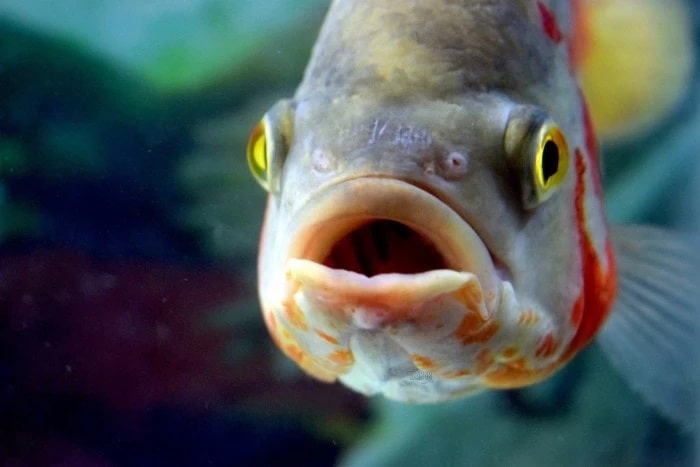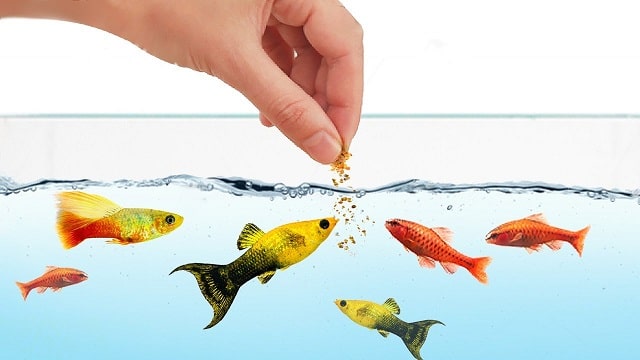It is essential to know the diet of each species in order to have an adequate diet with all the nutrients and vitamins.
Fish feed differently when they live outside their ecosystem. In their natural environment, these animals usually have prey and eat other smaller aquatic beings, such as larvae or other types of invertebrates. Most of the time, typical fish are carnivorous. However, sometimes they can also feed on plants or other types of algae. This changes significantly when we move these animals to aquariums, and their diet varies depending on their species and habitat: freshwater, saltwater, tropical or bottom fish.
It is essential to know the diet of each species in order to provide them with adequate food that provides all the nutrients and vitamins they need to be healthy and live for many years. As in all areas of life, fish food can be purchased or made by yourself. If you make it yourself, you will save a significant amount of money, and you will surely be feeding your fish better. Below is all the information on how to make homemade food for your fish: Related Article: Neon Fish: Characteristics And Necessary Care
What do fish eat?
This depends on the type of species, for example, cold-water fish are very easy to care for and feed. Flake food is highly recommended, as are granulated foods. We can also give them fresh foods such as mollusk meat, protein-rich worms, and raw meat or fish, avoiding those that contain too much fat or blood. Fish eggs and vegetables such as spinach or lettuce are highly recommended.
Tropical fish will feed on live and dry organic matter such as mosquito larvae, shrimp, or small worms. You can also choose to feed them flakes or pellets that provide them with nutrients, protein, or fiber. However, bottom-dwelling fish cannot eat flake foods. Try feeding them round tablets and discs because they are the most commonly used food for these species.
The ingredients of a home-cooked meal
Now that we know what these pets eat – or usually eat – in general, these are the ingredients that we can use to make homemade food suitable for all types of fish that we have in our aquarium. It will take you little time, you will feed your animals well and you will save, as we pointed out previously, a large amount of money, in addition to having food for at least two weeks.
To make it, we will need the following components:
1. Half a kilo of fish meat without scales
2. Half a kilo of cow liver and calf heart, which should be added without fat or nerves
3. Sweet paprika
4. A boiled egg
5. A carrot
6. A beet
7. Lemon juice
8. A head of peeled garlic
9. Four tablespoons of rolled oats, two tablespoons of a multivitamin preparation, and one tablespoon of soy lecithin, plus a quarter tablespoon of sodium benzoate and one tablespoon of glycerin for moisturizing.
From these materials we can prepare homemade food for our aquarium pets:
1. Once all the ingredients are mixed, we will proceed to blend it until we obtain the thickness of a porridge, to which we will have to add water until we obtain a semi-liquid fluid.
2. From here, a tray will be very useful to spread a thin and uniform layer of the porridge until it is covered.
3. After this, the next step is to place it in the oven at a low temperature, without exceeding 100º so as not to eliminate the vitamins that each of the nutrients possess.
4. Once the moisture has dried from the porridge, we will proceed to remove it from the oven using a spatula and trying to prevent the food from sticking to the tray. If it is not possible to remove it because it sticks too much, a tip is to leave the porridge in the tray outdoors for a night so that the humidity of the environment acts and isolates the food from the tray.
The amount of ingredients varies according to the needs and number of fish living in our aquarium. If our fish are more carnivorous, we can reduce the amount of vegetables. If, on the other hand, the fish are more accustomed to vegetable nutrients, we will have to increase them.
Some fish have eating disorders when they are transferred to aquariums. If this happens, it is recommended to stimulate their appetite with a vitamin complex, which can be obtained at a pharmacy or from a veterinarian. Before buying it, we should consult with an expert. Types Of Aquarium Lamps: The Ones You Should Know
How many times a day should you feed your fish?
Most people feed their fish at least twice a day, once in the morning and once in the afternoon. This is not correct, since we must simulate the times and the amount that they would eat if they were in their natural state. The most correct thing would be to provide them with food in small quantities four to six times a day.
It is very important to control the quantity so that they do not die from overfeeding. Otherwise, the fish can contract diseases, contaminate the water, and even die. The quality and adequate quantity of food that we give them will determine their good growth and development. A pinch of food will be enough. As far as possible, we should try to see that all the fish eat more or less the same.
How long can fish go without eating?

The time that these pets can go without food depends on various factors: the species, the state of their health, the care they have received since leaving their natural state, the quality of the water in which they live, and the food they have had, etc.
However, we can get a rough idea. Assuming that the conditions of the fish are normal, they could survive without ingesting nutrients for two or three days. After this time, the animal may feel a certain weakness due to the loss of defenses. If this happens, the fish can suffer health problems and contract various diseases.
There are rumors that fish can go without food for up to a week. This may or may not be true, but it is very difficult to achieve. When a fish needs to eat, you can see it in their behavior, as they tend to be more restless than usual and climb up to the upper layers of the water in search of food. Their skin and scales may lose their shine and color, appearing damaged.
Aquarium fish care
Food is not the only element that we must take care of when feeding our pets. The fish tank, lighting, and water are other factors that cannot be neglected because the more the natural habitat of these species is imitated, the better. We can use lighting to play with the temperature. If it is very bright, it will affect the degrees of the water, something very important for these animals. Playing with light and darkness will allow us to have a varied environment in the aquarium so that the fish will decide which to choose. Tips: How To Change Aquarium Water
Water is also important, if not the most important. Tap water is not the most suitable for fish, since chlorine can directly affect their gills. We have to regulate the pH of the water and change it frequently. If we do not have the basic knowledge of the type of fish and water that each species should have, we should seek the necessary guidance from people who know and have experience in the maintenance of these animals.
It is recommended that water filters be biological, as this allows existing waste to decompose. Gravel can also be used as a filter, and it also helps the plants in the fish tank to be properly maintained.
It is essential to know that cold-water fish cannot coexist with tropical fish, and if we have both species we must separate them in different fish tanks, with one water colder (for cold-water fish) than the other (tropical fish). The same occurs with saltwater or freshwater fish, which, obviously, cannot survive if we place them in another type of water to which they belong in their natural origin.
Finally, pay attention to swim bladder disease. We can see that our fish suffers from it when it swims upside down, seems clumsy, and does not move naturally or when it hits objects around it, among many other symptoms. Sometimes, this occurs as a result of several causes such as inadequate maintenance of aquatic conditions, viral or bacterial infections, sudden changes in temperature, or, in some species, poor nutrition can cause the bladder to not be able to inflate and deflate at the fish’s will.
To take into account
The health of our fish begins with a suitable place to live, with the correct water quality accompanied by the correct diet. Cold water fish are easier to keep, since they usually have a big appetite, although this does not mean that you can feed them anything. As an animal species, they need a diet that is suitable for their digestive system. On the other hand, food for tropical fish has to have the appropriate amounts of proteins, fats, and vitamins that you would get if they were in their natural habitat.
Please note that this is an informative article and is not written by a specialist. If you want to know all the details of how to care for and feed your aquarium fish, do not hesitate to contact an aquatic animal professional to resolve all your questions and concerns.
